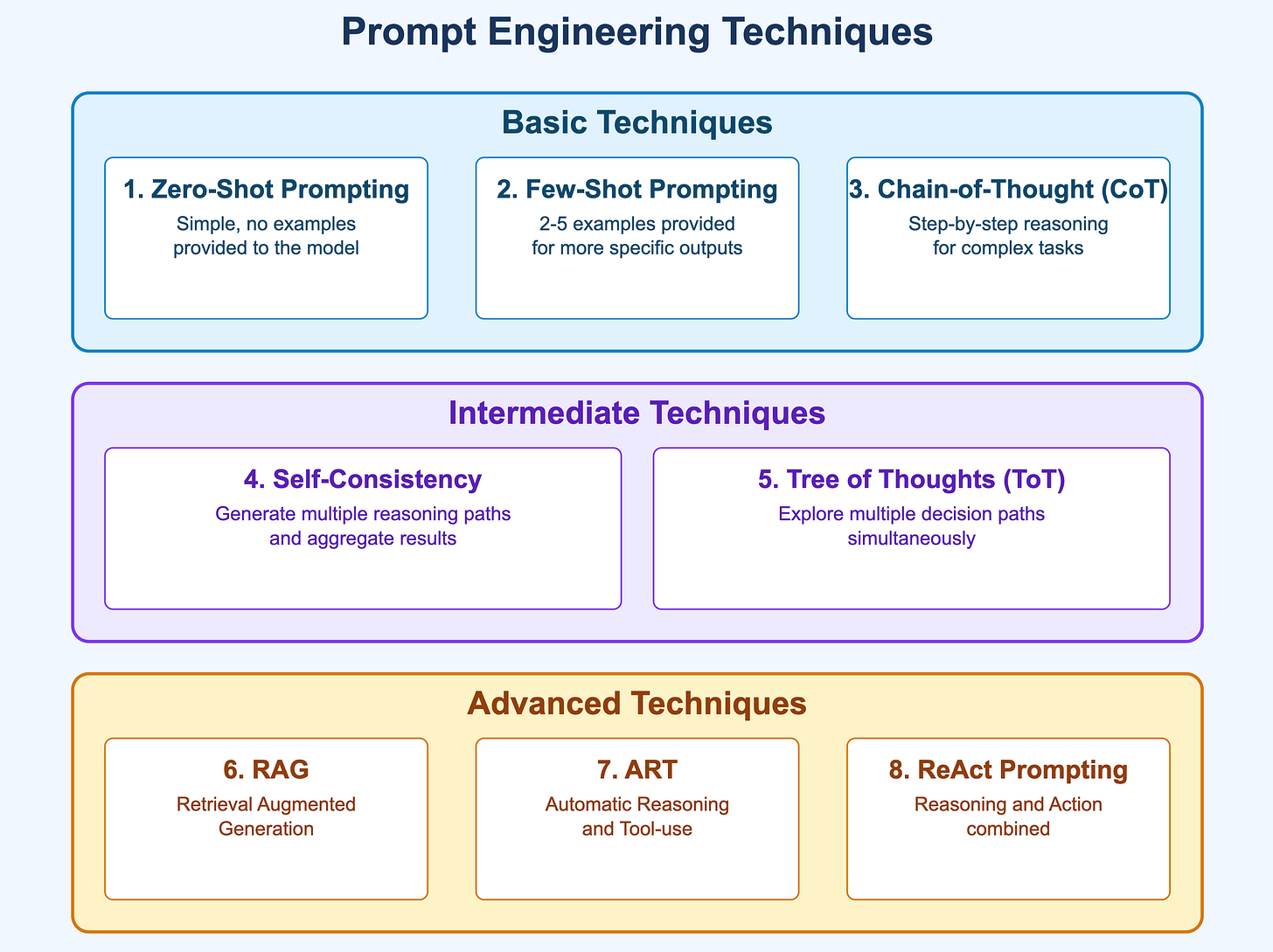Mastering Prompt Engineering: From Basics to Advanced Techniques - Part 1
The Art of Effective Prompting: AI and Beyond
Hello Neuro Evolution Community,
Welcome to our in-depth exploration of prompt engineering. As Large Language Models (LLMs) continue to reshape industries, mastering the art of crafting effective prompts has become a crucial skill. Whether you're in technology, healthcare, finance, or any other field, this newsletter will equip you with the knowledge to maximize AI-generated outputs and boost your productivity.
What is Prompt Engineering?
Before we dive into techniques, let's define our topic:
Prompt engineering is the art and science of designing and refining inputs (prompts) for AI models to elicit desired outputs. It's about communicating effectively with AI to achieve specific goals.
Now, let's explore foundational prompt engineering techniques with practical examples across various industries.
Basic Prompt Engineering Techniques
1. Zero-Shot Prompting
Zero-shot prompting involves giving a task to an LLM without providing examples. While straightforward, it often yields generic outputs due to lack of specific guidance.
Example (Technology):
Prompt: As an expert product manager for a fitness tracking app, you have recently introduced a new feature that lets users track their daily workout progress. How can you enhance this feature to improve user engagement and retention? Consider both user experience and business goals in your response. Provide 40 enhancements and then sort them based on importance.
Note: The output may be generic. If unsatisfied, consider refining the prompt with more specific criteria or using few-shot prompting.Pro Tip: Use zero-shot prompting for simple, straightforward tasks or as a starting point for more complex prompts.
2. Few-Shot Prompting
Few-shot prompting provides the LLM with 2-5 examples of the desired output format or style, guiding it towards more specific and relevant responses.
Example (Healthcare):
Prompt: Translate medical terms into layman's terms:
Myocardial infarction: Heart attack
Cerebrovascular accident: Stroke
Hypertension:
Dyspnea:
Xerostomia:
Note: We've provided two examples to guide the model's translation style.Pro Tip: Carefully select your examples to represent the range of outputs you're looking for.
3. Chain-of-Thought (CoT) Prompting
CoT prompting encourages the LLM to break down complex tasks into step-by-step reasoning, enhancing problem-solving capabilities.
Example (Finance):
Prompt: Calculate the compound interest on an investment of $10,000 at 5% annual interest rate for 3 years. Think through this step-by-step:
1. Identify the compound interest formula
2. Apply the formula for each year
3. Perform the final calculation
Provide your reasoning at each step.Pro Tip: Use CoT for complex problems that benefit from explicit reasoning steps.
Additional Considerations for Effective Prompt Engineering
Prompt Length & Clarity
Balance providing context with maintaining clarity. Aim for clear, concise instructions that guide the LLM without overwhelming it.
Example (Finance):
Poor: Analyze the stock market and suggest investments.
Improved: Based on current S&P 500 performance and recent economic indicators, suggest three potential investment sectors for a moderate-risk portfolio. Provide a brief rationale for each.Pro Tip: Test both short and long prompts to find the optimal balance for your specific task.
Iterative Refinement
Refine your prompt after each LLM output to get closer to the desired result.
Example (Technology):
Initial Prompt:
Generate a Python function to calculate the Fibonacci sequence.Refined Prompt:
Enhance the Python Fibonacci function to:
1. Include error handling for negative inputs
2. Optimize for large numbers using memoization
3. Add comments explaining the optimization techniquePro Tip: Keep a record of your prompt iterations to understand what works best for different tasks.
Conclusion
Mastering prompt engineering is an ongoing journey of experimentation and refinement. Start with the basics and areas of your own expertise to ensure the model’s output is accurate, gradually incorporate advanced techniques, and always consider the specific strengths and limitations of the LLM you're working with.
Things To Avoid:
Avoid relying on models to generate factual information. It does not replace subject matter experts.
Use with care on math and logic problems.
Do not share sensitive or proprietary information.
Applying Prompt Engineering to Personal Development
Let's take a moment to reflect on a crucial insight: The principles of prompt engineering aren't just applicable to AI—they're remarkably relevant to how we approach our own lives and goals.
Just as we craft precise, well-structured prompts for AI, we should "prompt our brains" effectively to tackle complex tasks in our personal and professional lives. Breaking down large problems into manageable steps, providing clear context, and iteratively refining our approach are all strategies that work as well for human cognition as they do for artificial intelligence.
Consider the parallel between effective prompt engineering and setting SMART goals (Specific, Measurable, Achievable, Relevant, Time-bound). Both methodologies increase the likelihood of achieving desired outcomes by providing clear direction and structure.
As you continue to hone your prompt engineering skills, challenge yourself to apply these same principles to your personal goal-setting and problem-solving processes. You may find that the techniques that help you communicate effectively with AI can also help you communicate more effectively with yourself and others, leading to greater productivity and success in all areas of life.
Remember, whether you're prompting an AI or prompting yourself, clarity, specificity, and thoughtful iteration are key to achieving the results you're looking for.
What's Next?
In Part 2 of our series, we'll dive into intermediate prompt engineering techniques, including Self-Consistency and Tree of Thoughts. These powerful methods will further enhance your ability to craft effective prompts for complex scenarios.
Stay curious, experiment, and let’s build the future together!







